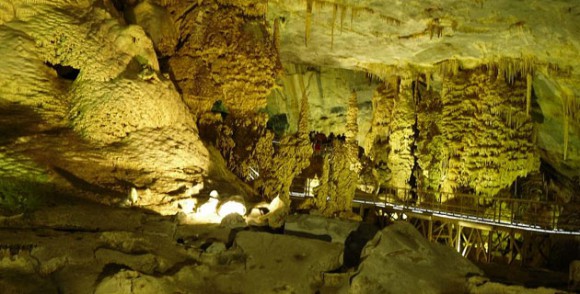The Garcia Caves (Grutas de García) are located in the Cumbres de Monterrey National Park, 9 km from the small town of Villa de García, and about 30 km from the city of Monterrey (state capital of Nuevo León). The highest point in the park is Copete de las Águilas which rises to 2260 m (7,410 ft) above sea level, but its best known peak is Saddle Hill (Cerro de la Silla), the distinctive saddle-shaped hill that overlooks the city.
Much of the park, including the mountains, are composed of sedimentary rocks that were originally laid down as marine sediments and then subsequently folded, uplifted and exposed to erosion. The extensive areas of limestone in the park, which date from the Cretaceous period, have been subject to karstification over 50 to 60 million years, which has resulted in typical karst landforms such as sinkholes, caves, cave formations and underground streams.
The Garcia Caves, one of the largest cave systems in Mexico, are deep inside the imposing Cerro del Fraile, a mountain whose summit rises to an elevation of 1080 meters above sea level, more than 700 meters above the main access road. The entrance to the caves is usually accessed via a short ride on a 625-meter cable car that was built to replace a funicular railway.
- 360-degree panoramic view of entrance [hold select button down on mouse, and drag to pan]
The cave system was first reported in 1843 by the Marmolejo family who informed their local prist Juan Antonio Sobrevilla that they had stumbled across it while looking for firewood.
Guided tours of the cave system show visitors some of its 27 separate chambers along a 2.5-kilometer (1.6 mile) route. The full system extends more than a kilometer further into the mountain reaching depths of more than 100 meters (340 feet) beneath the surface. The limestone of the cave walls contains lots of marine fossils. The caves have extensive and impressive formations of dripstone, including stalactities, stalagmites and other forms.
Unlike the suffocating heat of the Naica Crystal Caves in Chihuahua, the cave temperature here remains about 18̊C (65̊F) all year.
The chambers and formations have been given whimsical and imaginative names such as
- “El salón de la luz” (The Light Chamber) where the natural translucence of the ceiling rock allows light from the outside to filter through.
- “La octava maravilla” (The Eighth Wonder), a natural column formed where a stalagmite growing from the floor joined a stalactite, growing from the ceiling
- “El mirador de la mano”, a stalagmite shaped like a human hand.
- “El Nacimiento” (The Nativity),
- “La Fuente Congelada” (The Frozen Fountain),
- “La Torre China” (The Chinese Tower),
- “El teatro” (The Theatre), and
- “El Árbol de Navidad” (The Christmas Tree).
Want to read more about caves in Mexico?
Visit John Pint’s website for a selection of his writing, with many original articles, illustrated with great photographs, about many individual caves in Mexico.
Related posts
- The geography of Mexico’s caves
- Deepest water-filled sinkhole in the world: El Zacatón, Tamaulipas
- The world’s largest crystals grow in caves in Chihuahua, Mexico
- Mexico’s geomorphosites: El Sótano de las Golondrinas (Cave of the Swallows)
- Geotourism and geomorphosites in Mexico
- Mexico’s geomorphosites: the Primavera Forest, Guadalajara, Jalisco (with links to many other posts about geomorphosites)

Sorry, the comment form is closed at this time.